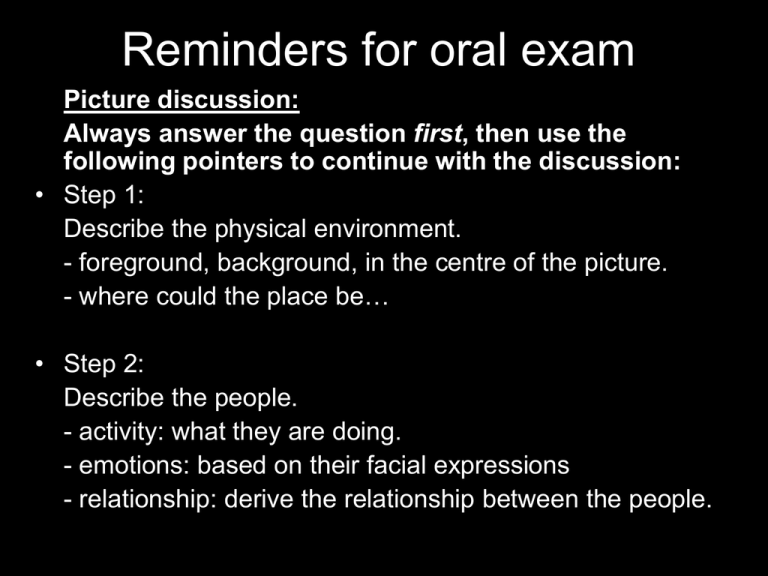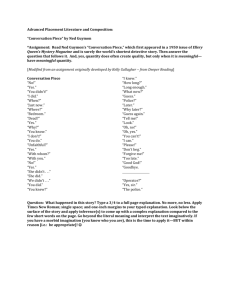Guidelines on Oral Examination
advertisement

Reminders for oral exam Picture discussion: Always answer the question first, then use the following pointers to continue with the discussion: • Step 1: Describe the physical environment. - foreground, background, in the centre of the picture. - where could the place be… • Step 2: Describe the people. - activity: what they are doing. - emotions: based on their facial expressions - relationship: derive the relationship between the people. • Step 3: - guess how the picture was taken – ie. was it posed or taken candidly. - link it to your personal experiences (eg. this picture actually reminds me of how I used to ride a bicycle in my neighbourhood..I really miss those days”) Typical questions for Picture Discussion What do you think is happening here? (Guessing the context of the picture) Say what the person is thinking/ feeling? (Guessing the thoughts/ feelings of a person via his/ her facial expressions & body language) What do you think may happen next/ what do you think may have happened before the picture was taken? (Guessing the outcome or the events that occurred before) Q: What is happening here? The three girls in the foreground of the picture seem immensely delighted. Judging from the slip of paper that the girl in the middle is holding, I guess this may well be the day that they were receiving their O Level results. Q: Say what the girl on the far right is thinking/ feeling? The girl on the far right is clasping her hand over her mouth – perhaps she is totally overwhelmed with joy so much so that she is on the verge of crying. I guess she must be pleasantly surprised by her own achievements and may be thinking of how she could have done so well. Q: What do you think may happen after the picture was taken? In the next few minutes, I think the girls would be making a lot of noise, comparing each others’ marks and making comments about each others’ achievements. When the commotion has dwindled, I guess they may settle down and start to discuss registration matters, or even talk about where and how to celebrate their success. Things that you can do to prepare for picture discussion • Prepare a list of vocabulary to replace overly used words/ phrases (eg. Nice, happy, sad, excited) • Go around and observe the people and things around you; deduce the purpose behind the activity you see and deduce the relationship of the people who are involved in the activity. Component 3: Conversation Impression management issues • • • • • Look at the examiner in the eye. Be confident – do not fidget!! Smile appropriately Acknowledge by nodding slightly. Mind your posture & body language. Component 3: Conversation Common words & phrases 1. “Well….” – to stall time and to show that you are thinking. 2.“As a matter of fact….” – to continue an issue with examples. Eg. Q: Have you ever been to a live concert before? Yes, I have – as a matter of fact, I’ve just attended a concert recently at the Esplanade… 3. “Personally speaking…” Component 3: Conversation Common words & phrases 4. “In my opinion…” Eg. Qn: Do you think casinos should be set up in Singapore? Well…in my opinion, casinos should not be set up in the near future. 5. “I reckon that…” – to replace “think”, “feel” 6. “I confer with the view that…” – to replace “agree” 7. “I differ with the view that students wearing school uniforms will perform better in their studies” Component 3: Conversation Common words & phrases 7. “I’m inclined to say that…” Eg. Qn: So do you think that students should not work part-time? Well…I’m inclined to say that this should be avoided as far as possible. 8. “I am doubtful” or “I doubt so” -- to replace “I don’t think so”. 9. “There are pros and cons to the issue..” -- to replace “good and bad things” Component 3: Conversation Common words & phrases 10. “I strongly believe…” 11. “In my humble opinion…” 12. “Prevalent social phenomenon…” Eg. I think addiction to gambling is a social phenomenon that is prevalent in most modern societies. 13. “In conclusion, I think we need to consider both the advantages and disadvantages of….” Component 3: Conversation Framing your answers • • Splitting your answers in points: Eg. “I can foresee three advantages/ disadvantages to this issue. Firstly…secondly…thirdly…” Breaking down your answers in terms of time: Eg. “Well, in the short run I think this is a good measure. However, in the long run, this may not work…” Component 3: Conversation Miscellaneous tips • • • • Give lot’s of examples from your own personal experience. Humour is good – but don’t push it. Drawing a conclusion with some morale or personal learning points. If you answer the question with a “no”, try to redirect the conversation to someone or something else. Eg. “Have you ever been to Australia?” “No, but I know of a close friend who has been there for several times…” Component 3: Conversation Miscellaneous tips • • • The conversion component is really about you – ie. your opinions of certain issues. Thus, you can prepare for this component by listing out a set of “FAQs” about yourself (eg. What are your views about students working part-time; what is your greatest achievement in life; what is your ambition) You may not be able to cover every possible issue, but at least it gets you into the mode of thinking… Component 3: Conversation Practice • • • • • “Have you ever been on a camping trip? Do you enjoy it?” “Tell me about your favourite hobby”. “Do you think Singaporean youths are too pampered?” “Have there been a time in your life when you’ve been cheated by a close friend?” “Do you think that the Singapore lifestyle is too stressful?”



